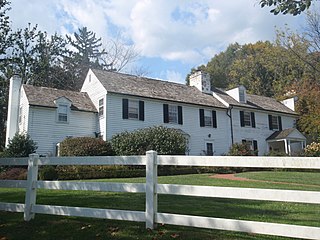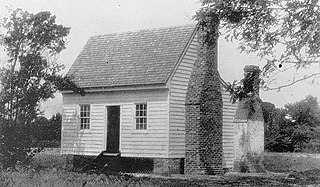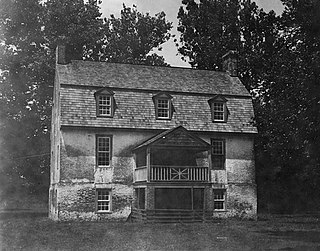
Zion Poplars Baptist Church is a historic Baptist church located near Gloucester, Gloucester County, Virginia. It was built in 1894 during the Reconstruction Era, and served more than just religious functions. As one of the oldest independent African American congregations in Gloucester County, Virginia, the church also served the economic and educational needs of its community. It was built in the Gothic Revival style with vernacular detailing, attributed to the handiwork of Frank Braxton, a former slave. The church gained its name from the historical origins of the church and congregation, because the first services were held under seven united poplar trees. Four of these trees still stand on church grounds today.

Holly Knoll, also known as the Robert R. Moton House, is a historic house in rural Gloucester County, Virginia, near Capahosic. It was the retirement home of the influential African-American educator Robert Russa Moton (1867-1940), and is the only known home of his to survive. It now houses the Gloucester Institute, a non-profit training center for African-American community leaders and educators. It was declared a National Historic Landmark in 1981.

This is a list of the National Register of Historic Places listings in Henrico County, Virginia.

Toddsbury is a historic home located on the banks of the North River in Gloucester County, Virginia. The house was built around 1669 by Thomas Todd and inhabited by his descendants until 1880. The builder Thomas Todd was the son of an English emigrant of the same name who patented land in Elizabeth City County in 1647 and in Gloucester County in 1664. However, he moved to Maryland and became a burgess for Baltimore County before dying at sea in 1676. The wife of one of the early settlers named Thomas Todd was Ann Gorsuch, daughter of Rev. John Gorsuch.

Lowland Cottage is a historic home located near Ware Neck, Gloucester County, Virginia. The main and earliest part of the house, considered to have been built between 1666 and 1676, is a gambrel roofed, 1+1⁄2-story structure, approximately 40 feet by 20 feet. Sometime between 1783 and 1831 Lowland Cottage received two additions: a 1+1⁄2-story gambrel-roofed wing on the east end, and a two-story wing on the north side. The house was remodeled in 1935.

Abingdon Glebe House is a historic home located near Gloucester, Gloucester County, Virginia. It was built around 1700, and is "T"-shaped brick structure with one-story hipped roof end pavilions flanking the central portion of the house. The central portion and rear ell are topped by steep gable roofs. It was extensively renovated about 1954. The house and surrounding glebe lands were owned by Abingdon Parish until they were confiscated by legislative act in 1802 as part of the Disestablishment. It was acquired by William Riddick of Gloucester in the 1980s, and was bequeathed to St. James On-the-Glebe Anglican Church, a parish of the Anglican Province of America, after Riddick's death in 2006.

Ware Parish Church is a historic Episcopal church located near Gloucester in Gloucester County, Virginia. One of the oldest surviving parish churches in the Commonwealth, Ware is the only one to retain its original three entrances. Ware Parish is one of the oldest in the state, formed in 1657, three years after Gloucester County's formation. The original building was on the opposite side of the river, the area still being known as "church field". Although a church was built on this site about 1690, the current generally accepted date for the one-story, rectangular brick structure topped by a steeply pitched gable roof is about 1715. Both structures were built during the rectorship of James Clack (1679-1723). Although the inside has been altered considerably, its exterior brickwork is well preserved, and other features include two double guillotine windows in the east end, five windows on each side, and one circular window over the western doorway.

Providence Presbyterian Church is a historic Presbyterian church located near Gum Spring, Louisa County, Virginia. It was built in 1747, and is a two-story, three-bay, wood-frame building measuring 50 feet, 3 inches, by 26 feet, 4 inches. It is one of the few frame churches in Virginia remaining from colonial times and was one of the first Presbyterian churches to be built in the central part of the state. Samuel Davies served as its first minister until 1759, when he assumed the presidency of Princeton University. A distinguished son of the church was Robert Lewis Dabney, noted mid-19th century Presbyterian minister and church architect.

Spring Hill Farm is a historic home located at Great Falls, Fairfax County, Virginia. It was built about 1822, and is a 2+1⁄2-story, frame farmhouse dwelling in the Federal style. A two-story rear wing was added in 1850. A 19th century south wing was replaced in 1972. Also on the property are two contributing barns, one apparently built before the American Civil War and one built in 1890.

Walter Reed Birthplace is a historic home located near Belroi, Gloucester County, Virginia. It was built around 1825 and is a one-story, gable-roofed frame dwelling. It has a rear shed addition. The house was restored in 1927 and again in 1970. It was the birthplace of Dr. Walter Reed.

Airville is a historic home located near Gloucester, Gloucester County, Virginia. It consists of two sections. The earliest section dates to the last half of the 18th century, and has a central-passage plan and gambrel roof. The second section is a three-story, frame addition dated to the late-1830s. It features a Greek Revival style front porch with fluted-Ionic order columns. Also on the property are the contributing dairy, smokehouse, office, lumber house, and icehouse.

Cappahosic House, also known as Baytop House and Cappahosic Ferry House, is a historic home located near Gloucester, Gloucester County, Virginia. It was built in around 1751, and is a two-story, three bay brick dwelling in the Georgian style. It has a basement and is topped by a standing seam jerkinhead red tin roof. The main block is connected in the rear to a two-story modern addition. Also on the property are contributing archaeological deposits dating principally to the 18th and 19th centuries. The house is believed to be on the site of an 18th-century ferry used to cross the York River.

Little England is a historic plantation house located near Gloucester, Gloucester County, Virginia. The plantation dates to a 1651 land grant to the Perrin family by Governor William Berkeley. Capt. John Perrin built the house on a point of land overlooking the York River directly across from Yorktown in 1716 with plans reputed to have been drawn by Christopher Wren. The house was used as a lookout for ships during the Battle of Yorktown. It is a 2+1⁄2-story, five bay, gable roofed brick dwelling in the Georgian style. A 1+1⁄2-story frame wing was added in 1954. It has a single pile plan and two interior end chimneys. The brickwork is Flemish Bond with few glazed headers. Little England is one of Virginia's least altered and best preserved colonial plantation homes. The interior features some of the finest colonial paneling in Virginia.

Timberneck is a historic home located near Wicomico, Gloucester County, Virginia. It was built about 1810, and is a two-story, three-bay, gable roofed frame dwelling in the Georgian style. The main house was enlarged by the addition of a frame wing in the mid-19th century.

Lands End is a historic home located near Naxera, Gloucester County, Virginia, United States. It was built about 1798, and is a two-story, three-bay, steeply-pitched gambrel-roofed brick dwelling. It has a single pile plan and a 2½-story rear wing. It was renovated in the 1960s.

Kempsville is a historic home located near Shacklefords, Gloucester County, Virginia. It was built about 1787, and is a 1+1⁄2-story, four-bay, gable roofed brick dwelling. with a single pile, central passage plan. It has a 1+1⁄2-story wing and rear ell. It features T-shaped chimneys.

Gloucester Women's Club, also known as Long Bridge Ordinary, is a historic women's club located at Gloucester Courthouse, Gloucester County, Virginia. It was built about 1750, and is a 1+1⁄2-story, three-bay, gable roofed frame Colonial era dwelling. A lean-to addition was built in the 19th century. The building is believed to have been originally constructed for commercial purposes. The property hosted the county fair after 1913, and in 1919 the building and surrounding acre of land were acquired by the Gloucester Women's Club.

Gloucester County Courthouse Square Historic District is a national historic district located at Gloucester Courthouse, Gloucester County, Virginia. The district encompasses 17 contributing buildings including the Gloucester County government buildings and those structures bordering the square, housing private businesses, offices and residences. The courthouse was built about 1766, and is a one-story, "T"-shaped brick structure with a hipped roof. Other notable buildings include the Botetourt Hotel ; the Botetourt Lodge; W. C. Tucker's Department Store Building; S and S Hobbies; and the Kearn's Real Estate storage house.

Gloucester Downtown Historic District is a national historic district located at Gloucester Courthouse, Gloucester County, Virginia. The district encompasses 57 contributing buildings and 5 contributing sites. It includes the central business district and limited residential development directly connected to the historic court circle and Main Street extending east to Edge Hill, to include the Gloucester Women's Club.

Bowstring Truss Bridge, also known as the Roaring Run Bowstring Truss Bridge and King Tubular Arch Truss Bridge, is a historic bowstring truss bridge located at the Ironto Rest Area near Ironto, Montgomery County, Virginia. It was built by the King Bridge Company in 1878, and is a single-span, four-panel tubular arch pony truss. It measures 55 feet (17 m) long, 12 feet (3.7 m) wide, and 6 feet 6 inches (1.98 m) high with an open roadway width of approximately 9 feet 6 inches (2.90 m). The bridge was partially disassembled and moved from its original location to a second site during the 1930s, where it remained until moved to its current location in 1977.























